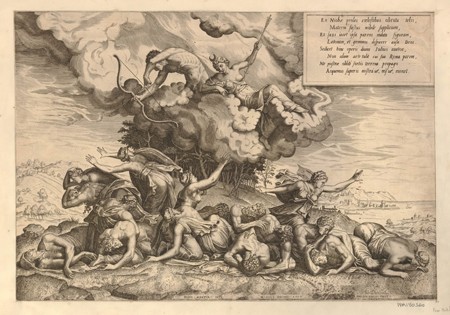Even now, Gere’s method of identification of the Ligorio drawings is systematically applied, and sometimes with manifestly erroneous results. This is the case for Diana and Apollo Killing the Children of Niobe, now in the National Gallery of Art, Washington. This work was attributed to Ligorio because it represents an episode treated in Polidoro’s decoration on the facade of the Palazzo Milesi in Rome, but the style of the drawing is completely different from Ligorio’s. In addition, the inventor of the composition was not Polidoro but Giulio Romano; in fact, the drawing is reproduced in reverse in an engraving by Philip Galle published in 1557 by Hieronymus Cock with the inscription IVLIVS MANTVA INVE. H. COCK. EXCVDE. 1557. PHILIPE GALLE FECIT. We also find mention of the copper plate in the inventory drawn up upon Cock’s death on March 1, 1601: “een coperen plaete van de Schieters van Julius Mantuanus.”
After pondering the assumptions on which Gere’s attributions were based, I decided to systematically examine the catalog of Ligorio’s early drawings in the Master Drawings article. It was my intention to gauge their authenticity on broader grounds, checking all the aspects of Ligorio’s particular style. I have thus begun to define and circumscribe all the characteristics of his early style. To that end, I have focused on a group of works that is surely autograph; that is, the sixteen well-known drawings illustrating the story of Hippolytus preserved in the Pierpont Morgan Library, New York, which I was able to study during a trip to New York. The material gathered during my stay at CASVA will be employed in the first chapter of my monograph on Ligorio’s drawings. “The Genesis of Ligorio’s Style,” which will serve as a general introduction to the volume.
Research carried out in the National Gallery of Art Library and image collections and the department of prints and drawings has radically modified my approach to Ligorio’s draftsmanship. During my residency, I also had the unique opportunity to become acquainted with the three hundred drawings registered in the checklist drawn up by David Coffin, the greatest specialist on Ligorio, and published as an appendix to his posthumous Pirro Ligorio: The Renaissance Artist, Architect, and Antiquarian (2004) with the purpose of serving as the groundwork for a catalogue raisonné of Ligorio’s drawings.

